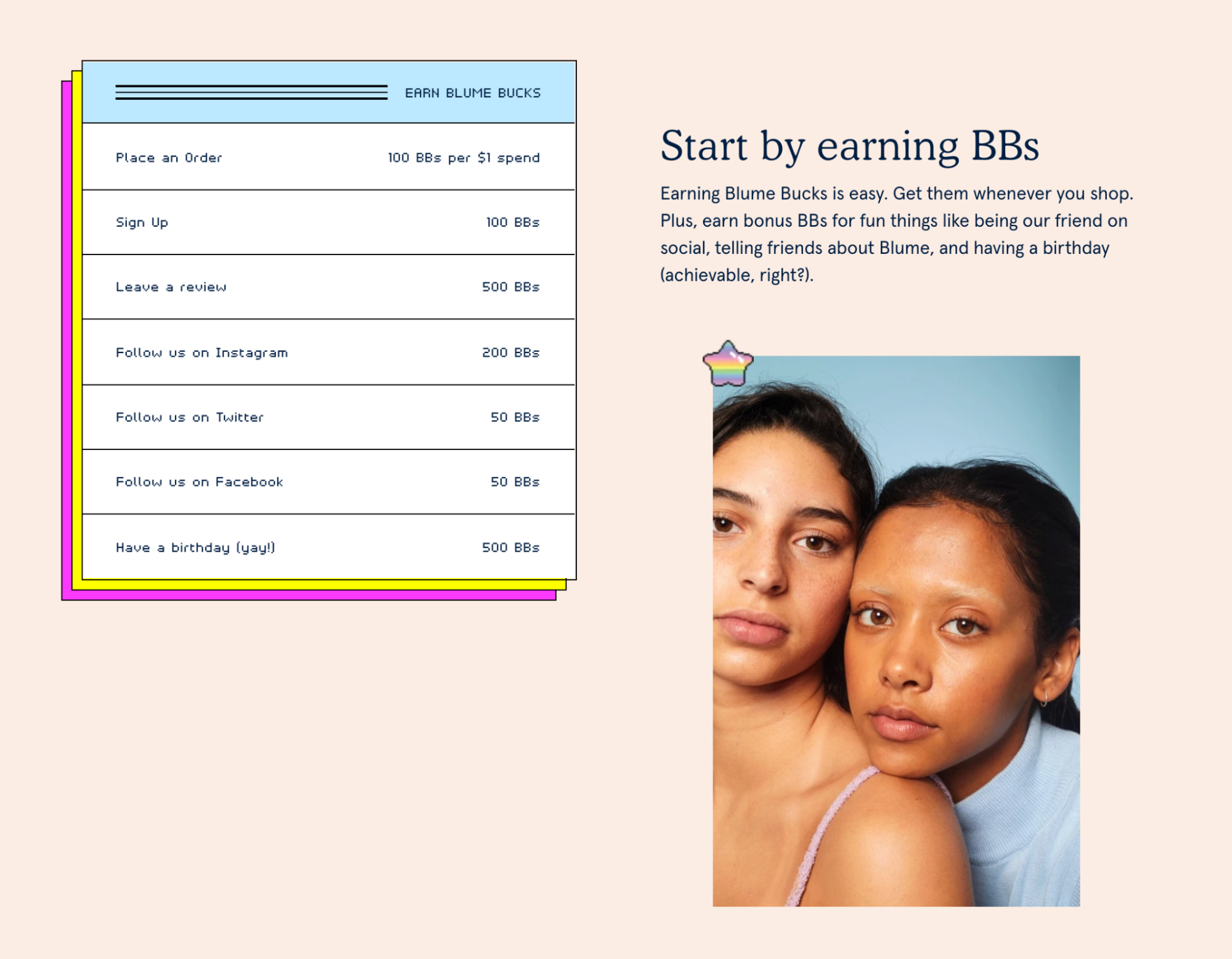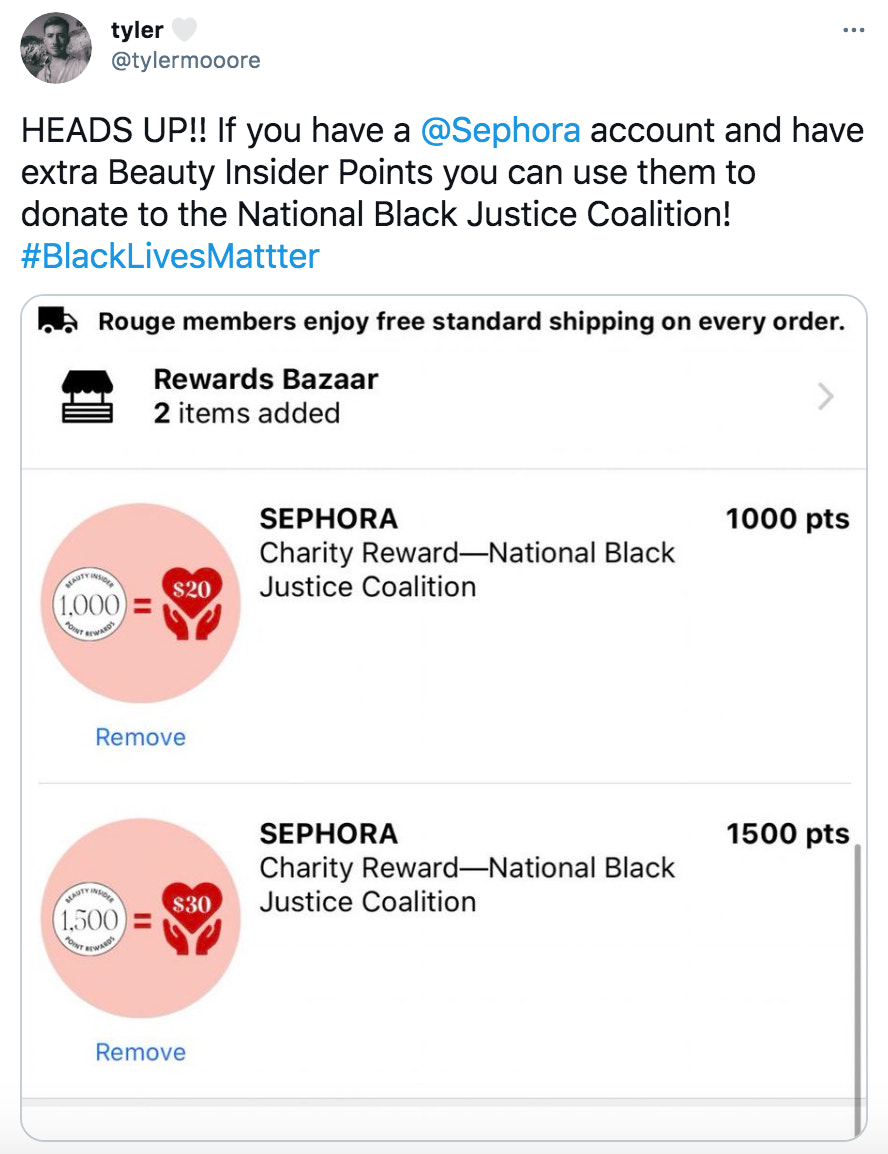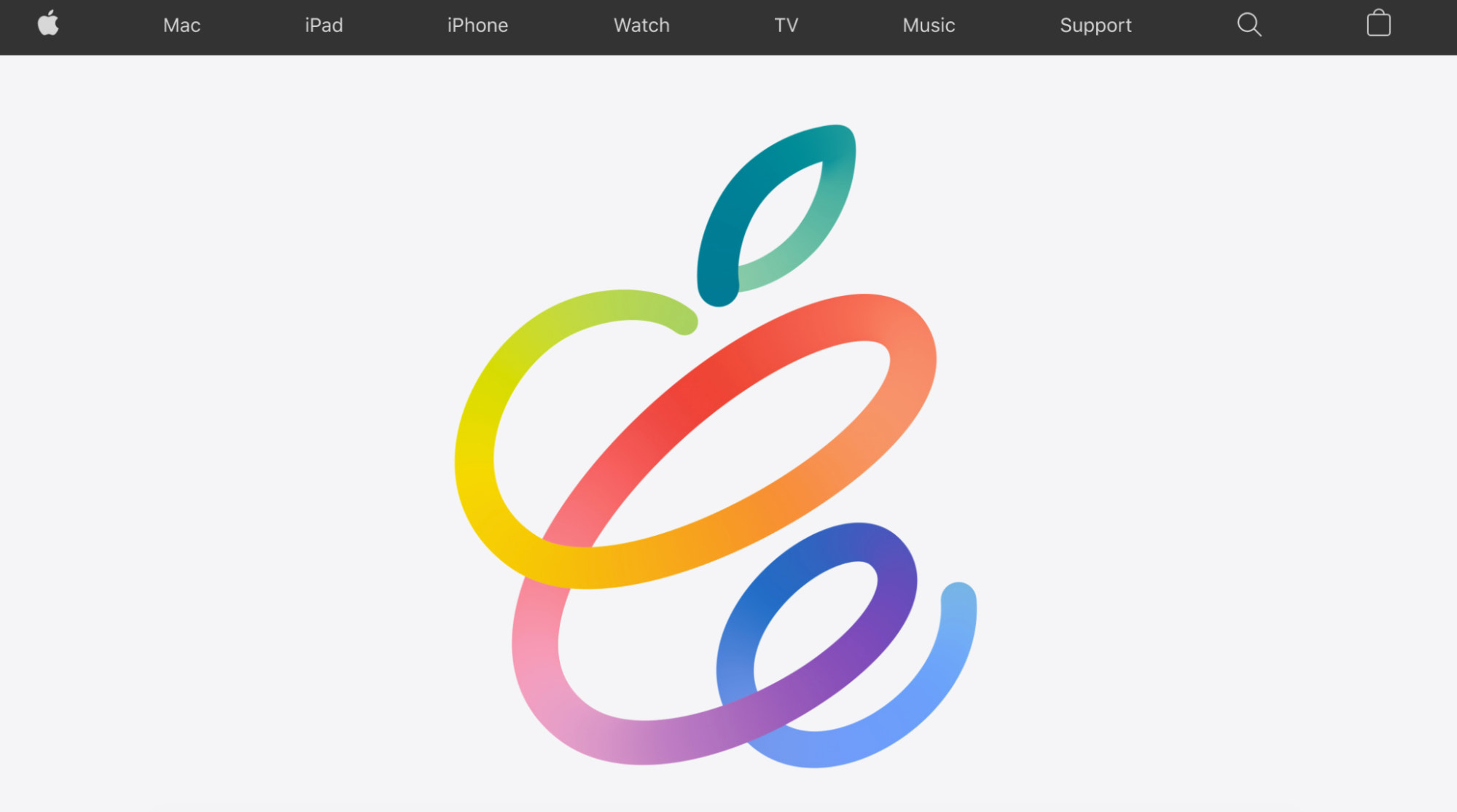More than90% of companieshave some type of customer loyalty program.
Loyalty programs have proven themselves as one of the most effective tactics for increasing revenue and inspiring customer loyalty. As many as84% of consumerssay they’re more apt to stick with a brand that offers a loyalty program. And 66% of consumers say the ability to earnrewards actually changes their spending behavior.
We know that it costs a lot less to sell to repeat customers than acquire new customers—that’s why brands invest in loyalty and rewards programs.
While they can be effective, customer loyalty programs are nothing new. Most fall into one of four categories: points, tiers, social media, and paid programs. That’s why some retailers are looking to shake things up and find innovative new ways to build rewards programs and inspire customer loyalty.
Table of Contents
What is a loyalty program?
Customer loyalty programs reward customers who repeatedly interact with a brand. It’s acustomer retention strategythat encourages customers to continue buying from your brand rather than competitors. The more a customer buys or engages with the brand, the more rewards they earn.
How customer loyalty programs work?
With a loyalty program, companies can offer points or benefits to customers. And in return, they redeem points for discounts, free products, rewards, or insider perks. The goal is to motivate repeat purchases and build trust between customer and business.
95% of customers say trusting a company increases their loyalty.
A recent poll from Yotpo revealed that people will go the distance for brands they love. Nearly68% of respondentssaid they’d join a customer loyalty program for brands they like, while 56% of those are willing to spend more with a brand even if cheaper options exist.
The study also found that people want more than free shipping and discounts. They want early access to sales and new products too.

Running a customer loyalty program means you’ll need to give away something. Be it discounts, sales, early access, etc. But the payoff for having rewards programs are huge:
- More customer referrals.If you have a great loyalty rewards program, people may tell their friends and family about it. More referrals equals more customers.
- Higher customer retention.If people find value in your customer loyalty program, they’ll likely stick around longer.
- More sales.Want a higheraverage order value? According to recentloyalty research, 49% of consumers agree they’ve spent more after joining a loyalty program.
- Brand advocacy.成功的忠诚计划可以把普通customers into brand advocates. This group helps your company get in front of new customers through word of mouth, which is a low-cost marketing strategy versus paid ads.
But not every loyalty program is the same. There are different types of rewards programs you can use to build customer loyalty and earn repeat purchases.
Read more:6 Ways to Reinvent Customer Delight: Unexpected Extras that Increase Loyalty
Types of rewards programs
- Points-based loyalty programs
- Tiered loyalty programs
- Paid loyalty programs
- Value-based loyalty programs
Now that you know how rewards programs work, let’s look at a few common types you can adapt for your ecommerce store.
1. Points-based loyalty programs
Points programs are the most common type of rewards programs. They let customers accumulate reward points they can redeem for freebies, cashback, perks, etc. Customers don’t just earn points from purchases. They can also earn points from sharing on social, leaving reviews, having a birthday, or through gamification.
Bodycare retailer Blume uses a points system called Blume Bucks in its loyalty program, dubbedBlumetopia. Customers can earn Blume Bucks by following the brand on Instagram, placing an order, or telling friends about Blume.

Customers can redeem their BB’s for merch, free products, and other cool gifts from Blume.

2. Tiered loyalty programs
Tiered customer loyalty programs are a type of membership where customers get different benefits depending on their rank. Businesses often rank membership into groups depending on certain metrics like sales or engagement.
These customer rewards programs give customers a goal. The higher their tier, the more exclusive and better rewards they’ll receive.
Bra and underwear brand ThirdLove uses a tiered system for its program,Hooked Rewards. Customers simply sign up for the program and start getting rewards right away. The more they spend with ThirdLove, the more perks they get.

Once a customer spends $250 with the brand, they become an Enthusiast. This tier receives more benefits, like free underwear with purchase and exclusive seasonal offers. If a customer spends more than $450 with the brand, they get access to giveaways and limited edition product drops.
3. Paid loyalty programs
Paid loyalty, or fee-based loyalty programs, give customers immediate and ongoing benefits for a participation fee. These fees can be recurring or one-time.
Paid programs may need to require proof-of-value to get signups, but the business can gain higher customer value from members. A recent report by McKinsey shows that consumers are62% more likelyto spend more on a brand after joining a paid loyalty program.
The most common example of a paid loyalty program is Amazon Prime. While it seems like a hard model to mimic, paid loyalty can suit many different business models.
McKinsey identified three elements that successful paid loyalty programs have in common:
- The benefits clearly outweigh the fees, which encouraged sign-ups.
- Members stick around for more experiential advantages, like personalized experiences and members-only content.
- Engagement levels are high. Good paid programs have a continuous flywheel of interaction that elevates the program's value.
4. Value-based loyalty programs
The idea behind a value-based loyalty program is to connect with customers on a deeper level. It involves donating a percentage of purchases to charity or welfare programs. You can offer multiple options for different charities to choose from or have one that genuinely aligns with your customers’ values.
This program doesn’t actually reward customers. But it holds a special place for them, as the rewards are used to benefit society. Brands often create a hybrid loyalty program using this model.
For example, Sephora lets membersdonate their reward pointsto the National Black Justice Coalition.

So, for example, if you have 500 points, you can donate $10 to the organization. 1,000 points nets you a $20 donation, and so on.
Not sure where to start? Ask customers what they want from a rewards program. You can easily run a survey or poll with your customer base to find out. Then create a rewards program accordingly.
最好的客户忠诚计划的例子
Here are our 7 picks for the most innovative customer loyalty programs and what you can learn from each. This will give you some customer loyalty program ideas to start your own today.
1. DSW

Designer Shoe Warehouse (or DSW) has long run a traditionalVIPloyalty program that rewards customers with points for each purchase and includes tiers of rewards that customers can unlock as they spend more.
Its program runs seamlessly. There’s no member ID number or credit card that customers have to remember—rather, DSW’s online system recognizes customers by their name, phone number, or payment information.
The danger when rewards become automatic is that customers forget about the program. Customers who forget about the loyalty program aren’t enticed to spend more to earn more. DSW needed a way to keep customers engaged with their program and remind them where they stood and what they could earn by spending more at DSW stores.
In early 2017, DSW launched an email campaign aimed at reminding customers about their program. The campaign consisted of a personalized email detailing:
- How many loyalty points they needed to get their next $10-off certificate
- Deals they currently were eligible for
- A snapshot of their interactions with the brand, including how long they’d been loyalty club members, how many points they’d earned, and how much they’d saved in the past two years.
What made the campaign so successful was the level of personalization. A loyalty program like DSW’s gives the brand access to tons of customer data. DSW used that to its advantage (along with some trusty email automation) to build emails that are hyper-personalized and relevant—a far cry from other generic marketing emails sitting in customers’ inboxes.
2. Sephora Beauty Insider

Sephora’s Beauty Insiderrewards program is wildly popular. It boasts more than25 million loyal members, and members make up as much as 80% of Sephora’s annual sales. Customers earn rewards for each purchase based on a traditional point system. The innovative part is that members can choose how to use their reward points.
One of the biggest barriers for a large swath of Sephora customers is price—Sephora products aren’t cheap. Beauty Insider members can redeem their rewards points for things like gift cards and discounts, helping to offset purchase prices without devaluing the products. Loyalty members can also redeem points for more exclusive things, like limited edition products or in-store beauty tutorials.
Giving loyalty members the flexibility to choose enables Sephora to offer customers the deals and products they really want without cheapening the perceived value of their products.
3. Starbucks Rewards

It’s common now for retailers to create a mobile app to manage loyalty programs, but when Starbucks first launchedStarbucks Rewardsthrough the Starbucks app, it was a new idea. Running the program through the app makes it radically easy for customers—no punch card to forget or lose, no sign-in required.
In order to earn loyalty points (or stars, in Starbucks’ case), customers must order or pay with the Starbucks app. Centralizing customer transactions this way creates a goldmine of data on customer preferences and behavior.
Go-to drink orders,customer lifetime value, frequently visited locations, seasonal favorites—by shepherding customers toward its app, Starbucks can gather information on all of these habits and more, empowering the brand to offer more relevant perks and communication to its customers.
If a loyalty app is doable for your online store, it can be a great way to collect and centralize customer data. Otherwise, a capablepoint-of-sale systemcan help you collect most of the same information.
4. Amazon Prime

Amazon’s Prime membership program is a well known paid loyalty program. For a flat annual fee, Prime members get access to unlimited free two-day shipping on millions of items, as well as other perks, like Amazon’s streaming service and Prime Day sales.
Amazon deals with heavy competition from other retailers like Walmart. You can find most of the products on Amazon elsewhere, too. Prime is how it differentiates itself and convinces customers to buy products through Amazon exclusively. And it works: Prime members spend an average offour times morethan other Amazon customers.
For retailers in similar industries where products and price points are very similar across competitors, your customer loyalty program can become a differentiator and competitive advantage.
Think of wholesale clubs like Costco. Give customers a reason to shop exclusively with you by offering value in addition to your products and service. By charging a membership fee, you can give yourself some wiggle room to offer truly valuable perks. An upfront investment also encourages consumers to validate their purchase by spending more with you.
5. The North Face

Apparel and outdoor gear retailer The North Face incentivizes loyalty members to earn more and more rewards by offering flexibility in how they’re redeemed—with options tailored to match its customers’ lifestyles.
Customers earn points with theXPLR Pass programin the traditional way on every purchase, and in some unique ways, like attending The North Face exclusive events, checking in at certain locations, and downloading The North Face app. When it comes time to redeem rewards, customers can use points toward unique travel experiences, like a mountain climbing adventure in Nepal.
“The XPLR Pass offers so many cool benefits for its members, like early access to limited edition collections and collaborations, opportunity to wear test products before they’re made available to the public, and product ‘field testing,’” explains Andrea Bosoni, founder ofZero To Marketing.
More than simply encouraging customers to spend more, The North Face’s rewards speak directly to its target consumers. They aren’t generic discounts on products—they’re curated experiences that help to build a stronger emotional connection between consumer and brand.
While sponsoring a hiking trip in Alaska may be outside your means as a small retailer, you can still create a reward and loyalty program that’s designed with your customers in mind and helps strengthen the bond between you.
6. REI Co-op

Consumers can be pretty cynical about brands and marketing initiatives. They know the end goal is always to convince them to buy more products and spend more money. That’s why the most innovative loyalty program takes the focus away from getting customers to spend more and re-centers itself on creating value for them.
REI’s program需要客户英航ck to the brand’s humble beginnings as a co-op—a company owned by its customers. For $20, customers can become a lifetime REI Co-op member. Once they join, customers gain access to serious value, like 10% back on all purchases, steeply discounted “garage sales,” and discounts on experiences like adventure classes.
At the end of the day, the best loyalty programs keep its sights on the customer—driving real value that actually speaks to the power of loyal customers and their effect on a business. Steep discounts aren’t realistic for small retailers, but by learning from many of the examples above, you can still find a financially viable way to be truly generous toward loyal customers.
7. Apple

This one is a little different, but there are few brands with a more fanatical and loyal following thanApple.
Sometimes, the most innovative loyalty program is no loyalty program at all. Not every retailer can build a loyal and dedicated customer base—the way Apple has—without offering rewards and incentives. But retailers selling truly unique products can.
By hooking new customers with your product itself, creating an amazingcustomer experience, and offering those benefits with every single purchase, you can eliminate the need for a traditional loyalty program altogether.

Free: Shopify Store Trust Checklist
Shopify’s research team conducted a series of in-depth interviews with North American shoppers to learn how customer trust is formed in online stores. This checklist is a summary of their findings, created to help business owners understand what essential aspects of their online store experience creates trust among customers, along with the trust-busting mistakes to avoid.
Get the checklist delivered right to your inbox.
Almost there: please enter your email below to gain instant access.
We'll also send you updates on new educational guides and success stories from the Shopify newsletter. We hate SPAM and promise to keep your email address safe.
When to add a loyalty program for your business
Every business today is competing for customer trust. One of the best ways to build this trust is through gratitude and providing customers with an experience they can’t find anywhere else. Rather than spending your time finding new customers, you can start a loyalty program to grow the relationship with your existing customers.
Establish customer loyalty from day one by ensuring that customer experience is taken into consideration for every customer touch point. This includes touch points before, during, and after purchase. Even if you don't create a loyalty program from the get-go, you can always ensure that each customer has a positive customer experience.
If you have a Shopify store, creating a loyalty program online is easy. You can download an app like Smile or Yotpo from theShopify AppStore and start today.

For example, with an app likeSmile,您可以创建奖励点咨询课题ams that engage customers in your store. It helps you with everything from program design to setting up a widget on your website to capture visitors’ attention and encourage them to sign up.
Customers will also have their own rewards portal on their phones, so they can manage their account, earn rewards, and redeem points anywhere.

Do things differently with your loyalty program
Over the last decade, customer loyalty programs and rewards programs have proven they’re an effective way toimprove customer retention rates, boost customer lifetime value, provide goodcustomer service, and inspire brand loyalty. While the low-key punch card has its place for some businesses, a truly innovative approach to customer loyalty programs can create huge value for retailers.
How will you reward customer loyalty with your own loyalty program?
Illustration by Rachel Tunstall
Ready to create your business? Start your free trial of Shopify—no credit card required.
Loyalty rewards programs FAQ
What are the best loyalty programs?
- DSW
- Sephora Beauty Insider
- Starbucks Rewards
- Amazon Prime
- The North Face
- REI Co-op


